
About Andrew Cusack
 Writer, web designer, etc.; born in New York; educated in Argentina, Scotland, and South Africa; now based in London.
Writer, web designer, etc.; born in New York; educated in Argentina, Scotland, and South Africa; now based in London. read more
News
Blogs
Reviews & Periodicals
Arts & Design
World
France
Mitteleuropa
Knickerbockers
Argentina
The Levant
Africa
Cape of Good Hope
Netherlands
Scandinavia
Québec
India
Muscovy
Germany
Academica
The New Yale Colleges
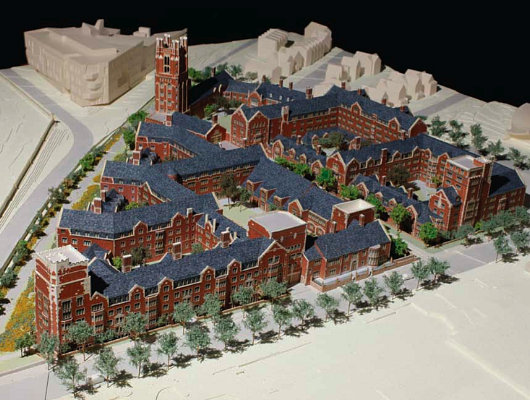
Yale University announced in 2008 that it would erect two new residential colleges in order to expand its undergraduate population without putting further strain on the twelve residential colleges that currently exist. Reportedly, Yale officials took a look at the new Whitman College at Princeton University, designed by traditional architect Demetri Porphyrios and decided even that wasn’t traditional enough. They commissioned Robert A. M. Stern, an architect who has, on occasion, proved exceptionally capable in traditional styles (the American Shingle style in particular), to design the two new colleges at the Connecticut university.
While the new colleges are currently being referred to as ‘North College’ and ‘South College’, there is little doubt that each college will find a generous benefactor who will endow it with funds and in return deign to allow the college to be named after the deep-pocketed soul.
The new colleges will, appropriately, be built in the Collegiate Gothic style, but will be faced in brick instead of stone. Brick facing in Gothic-style buildings always leaves one with a slight dissatisfaction, I’m afraid. Still, the decision to build in a traditional style is of course commendable.
For a commentary on the Collegiate Gothic of today, see this bit from Dino Marcantonio.
Here follow a few of the architect’s renderings of the new colleges.
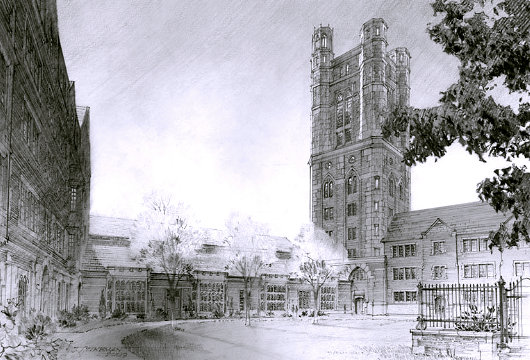
Illustration by Jeff Stikeman, for Robert A. M. Stern Architects
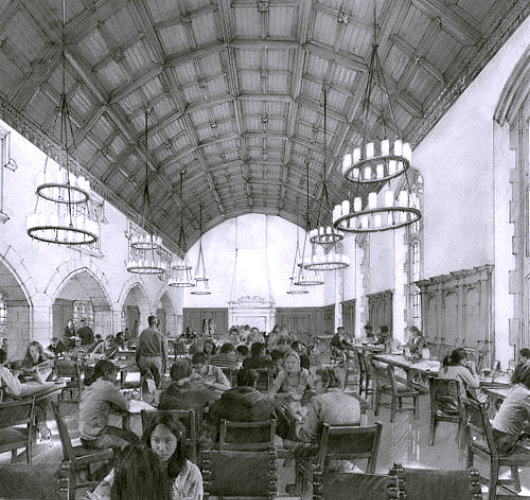
Illustration by Jeff Stikeman, for Robert A. M. Stern Architects
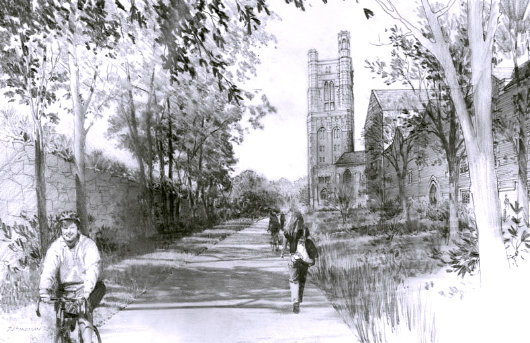
Illustration by Jeff Stikeman, for Robert A. M. Stern Architects
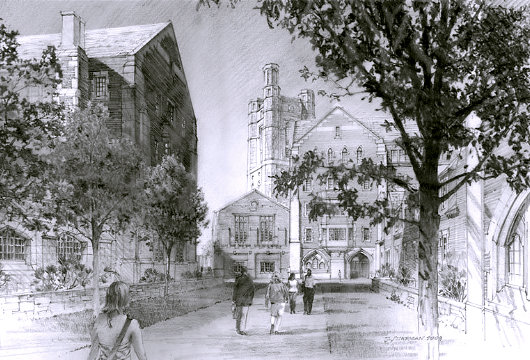
Illustration by Jeff Stikeman, for Robert A. M. Stern Architects

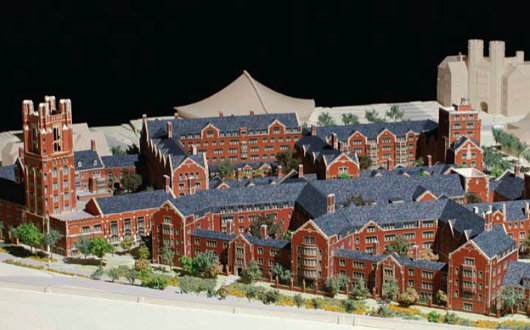
Search
Instagram: @andcusack
Click here for my Instagram photos.Most Recent Posts
- Silver Jubilee November 21, 2024
- Articles of Note: 11 November 2024 November 11, 2024
- Why do you read? November 5, 2024
- India November 4, 2024
- The Lithe Efficiency of the Old Constitution November 4, 2024
Most Recent Comments
Book Wishlist
Monthly Archives
Categories



I was at a lecture last year that Stern gave about the new colleges, at which he defended the decision to use brick by arguing that much of Yale’s architecture was, in fact, already brick-faced Gothic. I think it’s charming, in its way. Stern also mentioned that in order to build a traditionally-designed residential college in today’s legislative climate, it was necessary to get variances for many of the most important elements of the building: another example of how legislation makes culture boring, if you ask me.
To be honest, I (exceptionally among Yale students) was optimistic about the project. Unfortunately, though, the building project has been postponed indefinitely, thanks to a downturn in the college’s investments. The cost was projected at $300 million per college–I can only imagine how prodigally furnished the rooms were going to be.
I should add as well that, though in general I think my university to be a shamefully venal place, they have been good in the past about refusing to name residential colleges after living donors. People have tried, but so far the University has stuck to its guns: the new colleges will be named after someone either deserving or dead.
Stern designed the beautiful library at St. Paul’s School.
Has no one ever pointed out the problem of the uncanny valley to those doing architectural renderings?
“Brick facing in Gothic-style buildings always leaves one with a slight dissatisfaction, I’m afraid.”
Why is that? Because Backsteingotik simply isn’t your cup of tea? Not a snipe, just interested.
I should have specified modern Gothic buildings, specifically Collegiate Gothic buildings in America faced in brick. They tend to look cheaper than the stone-clad versions, but this might be because those who clad in stone generally invest more money in a better design, too.
I glad to see that Yale is doing its best to compensate for the vicious carbuncles that are Morse and Ezra Stiles Colleges- or at least making them look like they are. It is a pity that Eero Saarinen wasn’t as good as an architect as his father, or they wouldn’t have to.
I hope no one is surprised that they chose Robert A. M. Stern to design the colleges. He is the dean of their Architectural School!
As for the plans themselves, I an doubtful that they will be completed by 2012, when I (hopefully) will be attending!
I hope no one is surprised that they chose Robert A. M. Stern to design the colleges. He is the dean of their Architectual School!
As for the plans themselves, I an doubtful that they will be completed by 2012, when I (hopefully) will be attending! Oh well!
And another thing:
You must found a university in New England, preferably in Massachusetts, of the caliber of any of those in the Ivy League. Of course, the sole reason of doing this would be to found a Catholic university, and while there a scores of many good Catholic colleges, I do not feel there is one that quite is like any of the old Colonial Colleges. Obviously, you will hire the best architects today (anyone who has designed a building that is more than 50% glass is excluded), purchase the best land (like Knowles’ Devon, you ought to have one clean river and one turgid river running through your campus), have the best professors (no inane liberals, but perhaps you can make an exception for Tony Blair, considering he converted to Catholicism), with the best athletics (I’m rooting for the best college rugby and crew teams in the United States, football and football-that is not a mistake-not so much), and the best arts (this university shall singlehandedly bring back art from the dead!) in America!
Are you up for it?
The new colleges unfortunately will be separated from Yale’s main undergrad campus by the Grove Street Cemetery, a historic but walled-off expanse. To get to and from classes on Cross Campus or Old Campus, the ew residents will have to walk past the graveyard and law school. This distance will make it hard for the colleges’ residents to enjoy Yale’s undergrad esprit de corps.
On the other hand, the new colleges will not suffer too much from comparison to the fine older colleges (like Jonathan Edwards, Branford or Saybrook), since they will be quite distant from them.
As an avid collector of the Gothic Revival (books, furniture and objects, not buildings!), I am delighted to see Pugin proved right yet again. He predicted “Gothic for ever.”
One generally feels that collegiate Gothic died out after the west campus at Duke, and the 1930s additions to Yale and Princeton. This news, even delayed until the huge Yale endowment recovers after the recession, is most welcome to gothicists worldwide.
There are many Gothic Revival and reformed Gothic buildings made of brick, including the magnificently reused St Pancras Station and the Midland Hotel attached.
Variety! On a traditional campus as large as Yale, there needs to be a discriminating variety to prevent monotony. The college’s dormitories include Colonial (Dwight, Pierson, plus half of Silliman and Davenport), Modernist (Stiles and Morse), and lots and lots of Gothic (Edwards, Saybrook, Branford, Berkeley, Trumbull and Calhoun). Now architect R. A. M. Stern proposes two more for the Gothic list. Although I would have preferred Colonial (Yale’s style before it went gaga for all things Oxford), I’m grateful it isn’t in the latest architectural whim that will soon look tired and incongruous on a generally historicist campus.
But to make his colleges stand out (even while blending in) Stern has to do something different. Constructing them of brick makes perfect sense. It harkens back to the Hall of Graduate Studies, a brick Gothic-Deco mini-skyscraper. Besides, stone buildings today are generally just a veneer of stone over concrete. Brick is a facing, too, but it doesn’t pretend otherwise, so it’s more honest as a building material. And brick’s color radiates ruddy warmth, a pleasant contrast to the somber Grove Street Cemetery across the street.
And about the new colleges’ separation from the Old Campus, where most freshman room a year before going on to their residential colleges — I was in Silliman from day one, and like those in Dwight who also skip the Old Campus, suffered no ill effects.
Why is it that Princeton can afford to build stone buildings but Yale can only afford brick? They are equally wealthy, though granted Yale is larger.